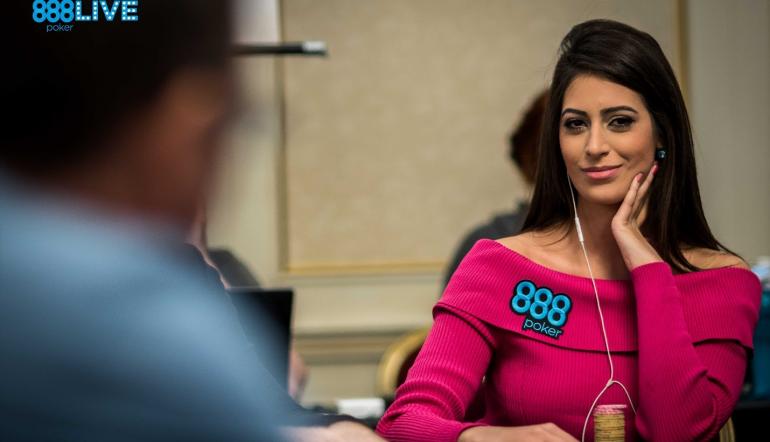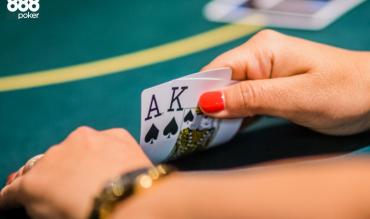Hand reading is often portrayed as a mystical skill that all the best poker players seem to possess. Possibly, psychic clairvoyance allowing them to peer into their opponent’s soul and deduce instantly the exact cards they are holding.
Seems like a great skill to have, right? Unfortunately, such other-worldly abilities are the stuff of myths and legends. Great hand reading requires practice and skill.
Here we will get to grips with what hand reading really is and how we can go about improving our hand reading skills.
Table of Contents
What is Hand Reading?
Put simply, the term “hand reading” describes the scientific process of attempting to figure out what type of hand our opponent is holding.
We use the term “scientific” since good hand reading is essentially a logical process of deduction.
Contrary to popular belief, the main goal of hand reading is not to be able to put our opponent on a specific hand but rather a range of possible hands that he might hold.
Our best play will be the one which accounts for our opponent’s entire range.
A Logical Process of Deduction
How exactly is hand reading a process of “deduction”?
Let’s illustrate this with an example. Imagine we are playing a $1/$2 No Limit Hold’em cash game.
Before any action – At this stage, it will be almost impossible to narrow down our opponents’ ranges. There are 1,326 possible combinations of hole cards in Hold’em, and our opponents could have any one of those (ignoring any card removal effects).
After the pre-flop betting round – As soon as our opponents begin to take various actions on the pre-flop betting round, we can narrow their range of possible holdings somewhat drastically. For example, if a player open raises from UTG (under the gun), he will usually hold less than 15% of those possible 1,326 pre-flop combinations.
If a player were to open-raise the BTN (button), we can’t narrow the range down as drastically, but we can still often remove over half of the 1,326 combos from our opponent’s range.
By the time we reach the flop, our opponent’s likely range will frequently consist somewhere in the region of a few hundred possible different combinations of two cards. That's still a lot to think about, but it’s a significant improvement relative to the initial 1,326 combinations.
The postflop betting rounds – The process of deduction continues on the later streets. Every time our opponent makes an action, we might ask ourselves the following two questions -
- Which hands make sense as part of our opponent’s line?
- Which hands definitely don’t make sense as part of our opponent’s line?
It might appear at first glance that these are both the same question but rephrased in opposite ways. However, thinking about the problem from both angles tends towards helping accuracy.
For example, if our opponent doesn’t raise our continuation bet on a draw-y flop texture, we can typically assume that he doesn’t have very strong holdings (such as Sets). This can help us later on in the hand if our opponent tries to represent a holding that we know he probably doesn’t have.
We’ll hence have three rough categories lurking in our mind -
1. Hands that Villain definitely doesn’t have in his range.
2. Hands that Villain might have in his range.
3. Hands that Villain definitely has in his range.
By the river – It's common at this stage to have narrowed our opponent’s range down to roughly 50 combinations of hole cards or less. Despite being a popular idea in poker media, we’ll rarely be able to know our opponent’s specific two cards.
Attempting to put our opponent on a specific hand is usually associated with poker amateurs. (There is a running joke in the industry that weaker players are always trying to put their opponent on Ace-King). It’s almost impossible to know Villain’s exact two cards, so attempting to guess usually results in strategic errors.
Besides, even narrowing our opponent’s range down to under 50 combos makes excellent decision-making highly possible. We’ll be able to play much more effectively with this knowledge compared to someone who only holds a weak idea regarding what his opponent might have.
Adjusting Based on Tells
Hand reading should, for the most part, be based on our opponents’ actions. This is not the only relevant area of focus, but it is very likely the most important. This is typically backwards from how poker is portrayed in the media. The general perception given to outsiders is that poker “tells” are the primary way that information is deduced regarding the strength of our opponent’s holding.
Tells are undoubtedly important, especially in a live poker setting. We’ll discuss what tells are and how we might use them in our hand reading process. It’s essential to put tells into context. However, good players realise that Villain’s actions are typically more important in the hand reading process than tells.
What Is a Poker Tell?

A “tell” is a piece of information (aside from our opponents’ betting actions) that leaks info regarding the type of hand that they may have. Experts in body language can use this data to great effect.
Here are some areas where poker tell experts look to augment their hand reading -
Nervousness - Does my opponent appear nervous? Why is this the case? Do his hands tremble? Does his voice quiver? Is there a visible indication of a pulse through his clothing?
Eyes – What does my opponent’s gaze, gaze-direction, and eye appearance tell me about him? Does he make eye contact with me, or does he look away? Did he glance quickly at his or our chip stack before deciding? Do his pupils appear dilated?
Voice – Does my opponent’s voice indicate that he might be nervous? How often does he vocalise his betting decisions in favour of using table signals? Does my opponent engage in table talk? Is he consistent with this, or does he frequently stop at specific points in a hand? In river scenarios, does my opponent’s talking imply he wants us to fold or call?
Betting Actions – How does my opponent place chips into the middle? Does he splash the pot or make bets in an orderly manner? Does this vary based on the type of hand he might have? How long does he take with his betting decisions on average? Do longer decision times imply particular kinds of holding?
Card Checks / Card Apexes – How often does my opponent check his hole cards? Does he check them mid-hand? If so, does he do this regularly, or does checking mid-hand imply a certain type of holding? When my opponent checks his hole cards, how long does he spend looking at them? (Referred to as “card apex”). Does he spend different amounts of time looking at different types of hole cards?
Miscellaneous – Does my opponent like to perform chip tricks? Is he consistent with this, or does he stop at specific points? What does this imply? Does my opponent use a card protector? Does he always use it or only at particular points?
Using Poker Tells
There is no guarantee that a particular tell means a specific type of hand. It changes from player to player.
We are mostly looking out for the following -
- Each player’s default profile - i.e. how they act normally.
- What changes to this default profile mean.
It’s hence likely that a period of observation is necessary before we can pick up on physical tells. To make matters more complicated, skilled live players may deliberately look to give off false tells. They act in a certain way in an attempt to convey something specific, but they are really trying to manipulate us.
The above reasons are why the line our opponent takes should be considered the most important determining factor in our hand reading process. Physical tells are not always that reliable. This is especially true for online players who don’t have any physical tells at their disposal. (There are still some tells that can be picked up on - timing tells, for example).
Employing Villain Profiles in Hand Reading
As discussed in the section on tells, different actions mean various things for all sorts of players. This is just as true for betting actions as it is for tells.
For example, when a “nit” plays aggressively, it means that he nearly always has a very strong hand. When a LAG (loose-aggressive) plays aggressively, it means something completely different; he could be bluffing with a much higher frequency.
We can refer to a player’s overall tendencies as his player profile. As we build up a sample size of hands with the players at our table, we should attempt to interpret the meaning of their actions within the context of their player profile.
The more we know about the specific opponents at our table, the more accurate our hand reading process can become. Taking exploitative lines based on knowledge of individual players is one of the most important techniques a poker player can learn to maximise winrate.
Common Mistakes With Hand Reading
Refusing to re-evaluate – Sometimes we might discount a specific type of holding from our opponent’s range, but his actions on future streets strongly indicate that he must still have that type of hand.
Understanding when to re-evaluate our earlier assumptions is an important skill. When we discount hands from our opponents’ ranges on the previous streets, we are tentatively removing them or assigning them a lower likelihood.
We need to remember that our opponents are capable of deliberately taking deceptive lines (this is poker after all). We shouldn’t stubbornly refuse to re-evaluate some of the assumptions we made earlier on in the hand.
Attempting to guess Villain’s exact hand – This is what amateur poker players do since they have not adequately developed sufficient hand reading skills. Occasionally we might see a recreational player make what appears to be a ridiculous call down, perhaps with an underpair in a large pot.
What was his rationale for doing so? He decided on an early street that his opponent had exactly AK-high and refused to re-evaluate that initial assumption in the face of forceful aggression. This is not hand reading; it’s guessing.
Assuming knowing a range, means knowing the best play – We might mistakenly believe that once we know Villain’s range that we can automatically deduce the best play. This is not necessarily the case. Knowing the best move and knowing Villain’s range are two separate pieces of information.
The best play will be based on Villain’s range, but it also requires a knowledge of Villain’s tendencies. For example, Villain likely has a mid-pair type hand on the river. Should we bluff? That depends on whether this specific Villain will ever fold a middle pair.
Practice, Practice, Practice
Hand reading takes a long time to master, a lifetime, in fact. It’s something we continually improve at doing as we train our brain to search for the relevant variables.
When we first start out, our hand reading process may be weak, because we don’t understand how to interpret certain types of action. As we gain more experience, we’ll be able to narrow down our opponent’s range significantly even based on some of the smaller pieces of information.
The first step for a newer player is to make the transition to thinking in ranges, rather than trying to guess the specific hand that our opponent might have.


